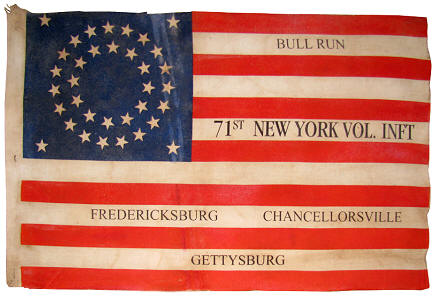|
 This
beautiful parade flag commemorates the 71st New
York Volunteer Infantry Regiment and its involvement in
four of the most significant battles of the American
Civil War. The 71st, known as "The American
Guard", mustered into service between June 20th and July
18,1861 for a three year term. Among the many
battles the unit heroically participated in are: Second
Bull Run, Fredericksburg, Chancellorsville, Gettysburg,
the Wilderness, Spotsylvania, Cold Harbor and
Petersburg. The unit was recalled to New York City and
was eventually mustered out of service in at the end of
its three year term on July 30, 1864. This flag
likely dates period circa 1880 to 1915, though it
presents 35 stars, which were official at the
time the unit disbanded in 1864 but which predate the
end of the war in 1865. The double medallion
consists of 31 stars with four corner stars, and its
configuration is striking compared to other medallion
flags of the period because of the absence of a center
star. One of the most unusual aspects of this rare
flag is the high quality of the printing and fineness of
the fabric used in its construction. Most parade
flags of this era were made of coarse cotton muslin and
of inferior quality to this flag. Only a handful of
these flags have surfaced, and I'm aware of only two
others. Overall, the flag, made for the veterans
of one of the hardest fighting regiments of the Civil
War, remains among the most beautiful and historically
significant printed parade flags known. This
beautiful parade flag commemorates the 71st New
York Volunteer Infantry Regiment and its involvement in
four of the most significant battles of the American
Civil War. The 71st, known as "The American
Guard", mustered into service between June 20th and July
18,1861 for a three year term. Among the many
battles the unit heroically participated in are: Second
Bull Run, Fredericksburg, Chancellorsville, Gettysburg,
the Wilderness, Spotsylvania, Cold Harbor and
Petersburg. The unit was recalled to New York City and
was eventually mustered out of service in at the end of
its three year term on July 30, 1864. This flag
likely dates period circa 1880 to 1915, though it
presents 35 stars, which were official at the
time the unit disbanded in 1864 but which predate the
end of the war in 1865. The double medallion
consists of 31 stars with four corner stars, and its
configuration is striking compared to other medallion
flags of the period because of the absence of a center
star. One of the most unusual aspects of this rare
flag is the high quality of the printing and fineness of
the fabric used in its construction. Most parade
flags of this era were made of coarse cotton muslin and
of inferior quality to this flag. Only a handful of
these flags have surfaced, and I'm aware of only two
others. Overall, the flag, made for the veterans
of one of the hardest fighting regiments of the Civil
War, remains among the most beautiful and historically
significant printed parade flags known.
The illustrious history
of the unit is as follows:
| |
"The 71st, the 2nd regiment of the Excelsior
brigade, composed of companies from New York
city, Olean, Great Valley, Colchester and
Kingston, N. Y., Newark and Orange, N. J., and
Philadelphia, Pa., was mustered into the service
of the United States at Camp Scott, Staten
island, June 20 to July 18, 1861, for a three
years' term. It left the state for Washington on
July 23; served for a time in the vicinity of
the city; was attached to Sickles' brigade,
Hooker's division; performed guard duty along
the Potomac, and in the advance under McClellan
was part of the 2nd brigade, 2nd division, 3d
corps. It was on trench and picket duty before
Yorktown; was present at the battle of Fair
Oaks, and lost 118 killed, wounded and missing
during the Seven Days' battles. It left the
Peninsula to go to the support of Gen. Pope at
Manassas and at Kettle Run, Groveton and in the
battle of Bull Run (second) lost 114 out of 250
engaged. During the Maryland campaign the
regiment was stationed in the vicinity of
Washington and marched to Falmouth in November,
arriving in time to participate in the battle of
Fredericksburg, but did not occupy an exposed
position. Winter quarters were established at
Falmouth and camp was broken late in April,
1863, for the Chancellorsville campaign, in
which the regiment took a prominent part. After
returning to camp at Falmouth for a short time,
it marched to Gettysburg and there participated
in the thick of the fighting with a loss of 91
killed, wounded or missing. It was also engaged
in the encounters at Wapping heights, Kelly's
ford, in the Mine Run fiasco, and after a
comparatively uneventful winter in camp near
Brandy Station, Va., entered upon the Wilderness
campaign in the 2nd brigade, 4th division, 2nd
corps. It was transferred May 13, to the 4th
brigade, 3d division, 2nd corps, with which it
served until the expiration of its term of
enlistment. The regiment was repeatedly in
action through the month of May, at the
Wilderness, Spottsylvania, the North Anna,
Totopotomy, Cold Harbor and Petersburg, and was
mustered out at New York city, July 30, 1864,
the veterans and recruits being transferred to
the 120th N. Y. infantry. It lost during service
94 by death from wounds and 74 from other
causes."1 |
|
1The Union army: a
history of military affairs in the loyal states, 1861-65
-- records of the regiments in the Union army --
cyclopedia of battles -- memoirs of commanders and
soldiers. Madison, WI: Federal Pub. Co., 1908.
volume II.
|

